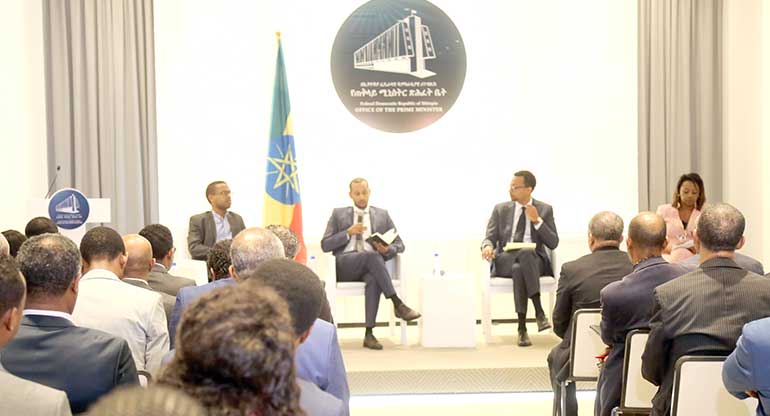
Nov 14 , 2020
By Asseged G. Medhin
A leader of an organisation needs to have a clear vision, something larger than life. But that vision needs to be sorted out in concert with employees for the organisation to be able to move forward, writes Asseged G.Medhin, deputy CEO of Global Insurance Company.
While it is obvious that a leader needs to be the owner of change, there is no agreement on what exactly constitutes the job of a manager. Different researchers and writers have tried to examine the functions of the manager. But a comprehensive answer is difficult to find.
One thing is clear though, the manager must deal with complexities that proceed from the very act of effectively matching resources. The ultimate failure of managers is their short-sightedness in using resources, particularly human resources, due to the fact that their leadership skills are latent during times of complexity.
Armed with myopia, some suggest that profit maximisation should be the objective goal of a leader. They say that a manager must strive for profits at all costs, as it is shareholders that matter most. Others think differently. They believe that a value-driven manager can set the tone for a value system in the organisation, and profits will follow. It is almost like suggesting a focus on customer satisfaction. But even this might be missing the point.
Few things matter like teaching the fish to swim even in troubled waters. Leaders, owning the change even if it is initiated at lower levels, should change the mindset of the employees, together managing and stirring the course. It is impossible to deal with a complex situation within an organisation if employees are not part and parcel of the solution.
Some of the greatest business leaders have said as much. Jim Tregbig, founder of Tandom Computers, said that every person is a human being and deserves to be treated as such. The famous Indian business guru J.R.D. Tata agreed that the treatment of employees is critical during adverse and complex situations.
What they make clear is that the leadership style at the top decides how the organisation is run. The direction the leader gives sets it on a path, and the success is determined by the pace it moves down the hierarchy. Changing the vision works best by addressing how that is effected – toward a solution where employees are part of the process. That is also when the bottom line can change.
To begin with, the leader needs to have a clear vision, something larger than life. But that vision needs to be sorted out in concert with employees since an idea that was initially unsought can make itself conspicuous. This journey will fuel and serve as an engine to the vision, whereby iterative engagement on the path reduces potentially adverse externalities.
To actualise this, the leader must be an assertive decision-maker. An indisputable trait of a good leader is decisiveness. If one has a hard time making a decision, then that person is probably not cut out to be a leader. The impact of indecisiveness in complex situations is so significant that it may bring about a haphazard end to the business.
In the process, a leader can come face to face with paradoxes, which must be resolved.
“Effective leadership involves the acceptance and management of paradox,” Jack Welch, the former CEO of General Electric, once said.
He is saying two things. First, accept the paradoxical situation. Do not run away from it or sweep it under the rug. It is not to be resented but tolerated. After that, plan how to manage that situation.
A leader must see in every problem, even a paradox, an opportunity that advances the interests of the organisation. By doing this, he will convince and lead followers until the situation is reversed and the organisation moves forward. But to do this, it is critical to build trust within the team. They must be able to work together like a well-oiled machine. Otherwise, the second that the company must change lanes, it would simply break down as a result of its rigidity.
Such trust among the team emanates when the leader expresses certain traits, such as respect for employees, a sense of fairness, transparency and honesty of character. These are cornerstones in building relationships, and they institute the notion of win-win solutions. There should be a mentality of abundance. There is plenty out there for everybody, and the fruits of that vision can be shared relatively fairly.
When the leader has respect for others, has a sense of fair play and is transparent, a congruence results. It all adds up. The words and actions of a leader, when consistently exhibited to be a sense of fair play, will create harmony. It is only when the organisation has internal harmony that it can compete meaningfully with others in the free market economy.
“Integrity is telling myself the truth. And honesty is telling the truth to other people,” said Spencer Johnson (MD), author of the business fable “Who Moved My Cheese?”
This is as true a lesson in life as in business. The fair leader is respected, admired and idolised. Unfortunately, there are very few that can objectively and fair-mindedly make decisions. It serves them well during times of turbulence and complexity, which the world is increasingly becoming.
PUBLISHED ON
Nov 14,2020 [ VOL
21 , NO
1072]



Sunday with Eden | Aug 14,2021

View From Arada | Oct 09,2021

Radar | Nov 12,2022

Viewpoints | Jan 03,2021

Sunday with Eden | Feb 12,2022

Radar | Jun 27,2020

Fortune News | Jul 21,2024

Commentaries | Oct 24,2020

Fortune News | May 23,2021

My Opinion | 132105 Views | Aug 14,2021

My Opinion | 128507 Views | Aug 21,2021

My Opinion | 126435 Views | Sep 10,2021

My Opinion | 124046 Views | Aug 07,2021





Dec 22 , 2024 . By TIZITA SHEWAFERAW
Charged with transforming colossal state-owned enterprises into modern and competitiv...

Aug 18 , 2024 . By AKSAH ITALO
Although predictable Yonas Zerihun's job in the ride-hailing service is not immune to...

Jul 28 , 2024 . By TIZITA SHEWAFERAW
Unhabitual, perhaps too many, Samuel Gebreyohannes, 38, used to occasionally enjoy a couple of beers at breakfast. However, he recently swit...

Jul 13 , 2024 . By AKSAH ITALO
Investors who rely on tractors, trucks, and field vehicles for commuting, transporting commodities, and f...

Jul 12 , 2025
Political leaders and their policy advisors often promise great leaps forward, yet th...

Jul 5 , 2025
Six years ago, Ethiopia was the darling of international liberal commentators. A year...

Jun 28 , 2025
Meseret Damtie, the assertive auditor general, has never been shy about naming names...

Jun 21 , 2025
A well-worn adage says, “Budget is not destiny, but it is direction.” Examining t...

Jul 13 , 2025 . By YITBAREK GETACHEW
The Addis Abeba City Revenue Bureau has introduced a new directive set to reshape how...

Jul 13 , 2025 . By BEZAWIT HULUAGER
Addis Abeba has approved a record 350 billion Br budget for the 2025/26 fiscal year,...

Jul 13 , 2025 . By RUTH BERHANU
The Addis Abeba Revenue Bureau has scrapped a value-added tax (VAT) on unprocessed ve...

Jul 13 , 2025 . By NAHOM AYELE
Federal lawmakers have finally brought closure to a protracted and contentious tax de...